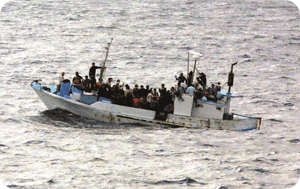Earth-observation technology helps to rescue immigrants in distress on the sea

On 17 September 38 sub-Saharan immigrants, including three babies and eight women, were rescued from a boat adrift on the high seas to the south of Motril (Granada, Spain).
According to Salvamento Marítimo (The Maritime Rescue Service) the search for the boat was “complicated” due to the huge area to be scanned. Nonetheless the SAGRES program, used in conjunction with satellite images, was decisive in finding the tiny boat with the immigrants in distress.
The GMV-coordinated, FP7, maritime safety project called SAGRES (Service Activations for GRowing Eurosur Success) supports the pre-operational test and deployment of high-time critical, intelligence-driven maritime surveillance components.
This particular activation (as one of the last activations within the project) was planned in advance with cooperation with Frontex, the European Agency for the Management of Operational Cooperation at the External Borders, defining a limited area within the Mediterranean Sea for a limited period of time: 16-09-2014 evening. The activation defined a set of exercises with the aim to further tests the capability of Earth Observation (EO) imagery to support maritime surveillance within specific operational environments.
The challenging trial was organized with the cooperation of Spanish authorities where it was planned to involve a patrolling vessel in the West Mediterranean Sea. The goal was to detect a small target (non-metallic target with a length < 10 m) by combining the processing of EO images with cooperative reporting streams.
However, on 16.09.2014 afternoon an urgent call to search for a boat with migrants was received and the asset was forced to join the mission.
Luckily, the operational search zone was not far away from the area designed for the trial. Thus, SAGRES and Frontex decided to use the ordered image, a Synthetic Aperture Radar image acquired by the RADARSAT2 satellite sensor in Ultra Fine mode with 3 m of resolution, to support the mission.
The image was processed in less than 3 h from the acquisition time. The ship detection report pointed out the presence of a potential target of interest cruising to the North. The report was immediately passed to Frontex, who passed away to the Spanish Authorities. The coordinates of the detection were used to delimitate the search zone and this permitted the location of the boat on the morning of 09.17 ,5 NM far away from the position reported by the satellite image.
Thanks to the rapid intervention of the Spanish authorities, the 38 migrants (including 8 women and 3 babies) on-board were rescued and saved their lives.
The contribution of SAGRES has been essential as the EO-based ship detection permitted reducing the initial huge area and this eased the search mission. This success case shows how EO technology can support high time critical maritime surveillance and how this technology can be used to save lives at sea.